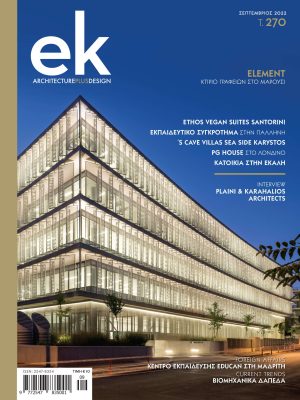Contemporary Architecture and Material Recycling
Over the past two months, major international architecture exhibitions have opened, showcasing new projects while highlighting contemporary approaches to critical design issues. In nearly all of these exhibitions and in related publications, proposals are being put forward to address environmental challenges through design.
It is no coincidence that at the Venice Biennale this year, the Golden Lion for Best National Pavilion was awarded to Bahrain and Diller Scofidio + Renfro, for their proposal to create a space where lagoon water is filtered and then used to make coffee for the exhibition’s visitors. The ecological message carried by such a gesture is perhaps more important than the architectural quality of the project itself. The international architectural community has clearly received the message: we cannot continue designing and building as we did only a few decades ago.
In this direction, many architectural offices around the world are adopting both the practice of reusing existing materials and maximizing the use of fully recyclable ones -with particularly interesting results. Examples from recent international exhibitions include the German Pavilion by LAVA Architects at Expo 2025 in Osaka, dedicated to minimizing resource consumption and promoting the principles of the circular economy, as well as MVRDV’s participation in Bangkok Design Week, where they presented a striking colorful “carpet” for public event spaces made entirely from recyclable composite material.
The durability and potential for reuse offered by natural stones remain a strong incentive for their use in construction today, as highlighted in the recent and highly successful event organized by ek architectural publications, Material Matters Vol. 6: Marble and Stone. Their use is not incompatible with the principles of sustainability, provided that sustainable (non-intensive) quarrying practices are followed and that locally sourced materials are chosen for each project.
The idea of reusing demolition materials has been a common practice in many parts of the world for centuries. A characteristic example is the incorporation of spolia from ancient structures, still visible today in medieval buildings and churches. A more recent case is the famous paving project by Dimitris Pikionis on Filopappou Hill, which incorporated fragments from neoclassical buildings demolished in Athens.
However, for such a practice to be widely adopted today, proper organization would be required: systems for collecting, cleaning, and especially storing demolition materials so they can be reused, as well as skilled craftsmen to handle and integrate them. It is particularly interesting that for nearly two centuries (during the Edo period, 17th–19th c. AD), material recycling was carried out extensively and effectively in Japan, a country with strong administrative organization, when circumstances demanded it.
Why not today, when the need to conserve resources is more pressing than ever? The architectural community is ready to respond.
Ariadni Vozani






































